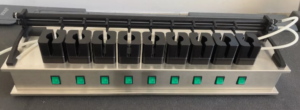Snot So Simple
Laaaadies and Gentlemen, scientists and spectators, chemists and curious minds…
Welcome back to the most exhilarating game show in pharmaceutical history – the one, the only… “Snot So Simple”
Over the last eight weeks, we’ve watched our contenders solubilize and stabilize, with unfit candidates eliminated at every step. But this past week, the pressure reached an all-time high. With the finish line in sight, one final trial stood between them and glory – Permeability Studies!
It is my honor to introduce you all to the contestants that advanced to this last and final next round:

These top seven chemical contenders took on the ultimate test in nasal spray formulation… The fearsome, the formidable – Franz Diffusion Cell!
Did they pass through the membrane…. or linger forever in the donor chamber?
There is only one way to find out!
Only the most permeable will diffuse.
Only the most bioavailable will advance.
And only ONE will become the chosen formulation!
So grab your lab coats, prime your pipettes, and let’s dive into how this final challenge went down– because this week was all about PERMEABILITY!
Although nasal delivery bypasses major barriers such as the digestive enzymes, liver metabolism, and the Blood-Brain-Barrier (BBB), the medication still must penetrate through the tissues of the nasal mucosa to reach the brain. The purpose of these studies is to confirm exactly that — ensuring the medicine we’ve developed up until this point is actually reaching its target site.
The porcine sublingual membrane mimics the function of the human nasal tissues. In essence, this phase of testing models how much of the drug will successfully pass through the nasal mucosa and become bioavailable in the brain.
First each solution was placed into a Franz Diffusion Cell, like the one below:

We filled the donor chamber with one of the select solutions, placed a porcine sublingual membrane between the flat ground joints, and clamped the cell shut to prevent leakage and evaporation.
In this way, we filled seven Franz Diffusion cells, and placed them into the slots of the In Vitro machine (pictured below). The two protruding tubes in the back of each cell were connected to the white water pipes of the in vitro model which was connected to a heater, in order to maintain temperature and stable testing environments. Furthermore, this allowed us to run permeability tests on all of the seven formulations at once since permeability studies are comparative.

After all the samples were placed in the in vitro model, we waited till the formulations began diffusing from the donor cell through the sublingual membrane and into the recipient chamber. We then collected aliquots at regular intervals by drawing fixed volumes of the solution from the recipient chamber via the sampling port using a syringe. The a stir ball within the recipient chamber ensured uniform composition. By analyzing the concentrations of these samples, we determined how much of each formulation had permeated through the membrane and at what rate.
The winner of this challenge was the one that output the highest concentration, the fastest!
The higher percentage of the formulation detected in the recipient chamber indicates greater potential for brain bioavailability. This is a true measure of the medication’s effectiveness, as higher bioavailability directly correlates to needing lower doses and fewer administrations, minimizing any side effects!
But to find out which formulation proved to be the most permeable and promising, you’ll have to come back next week!

Comments:
All viewpoints are welcome but profane, threatening, disrespectful, or harassing comments will not be tolerated and are subject to moderation up to, and including, full deletion.